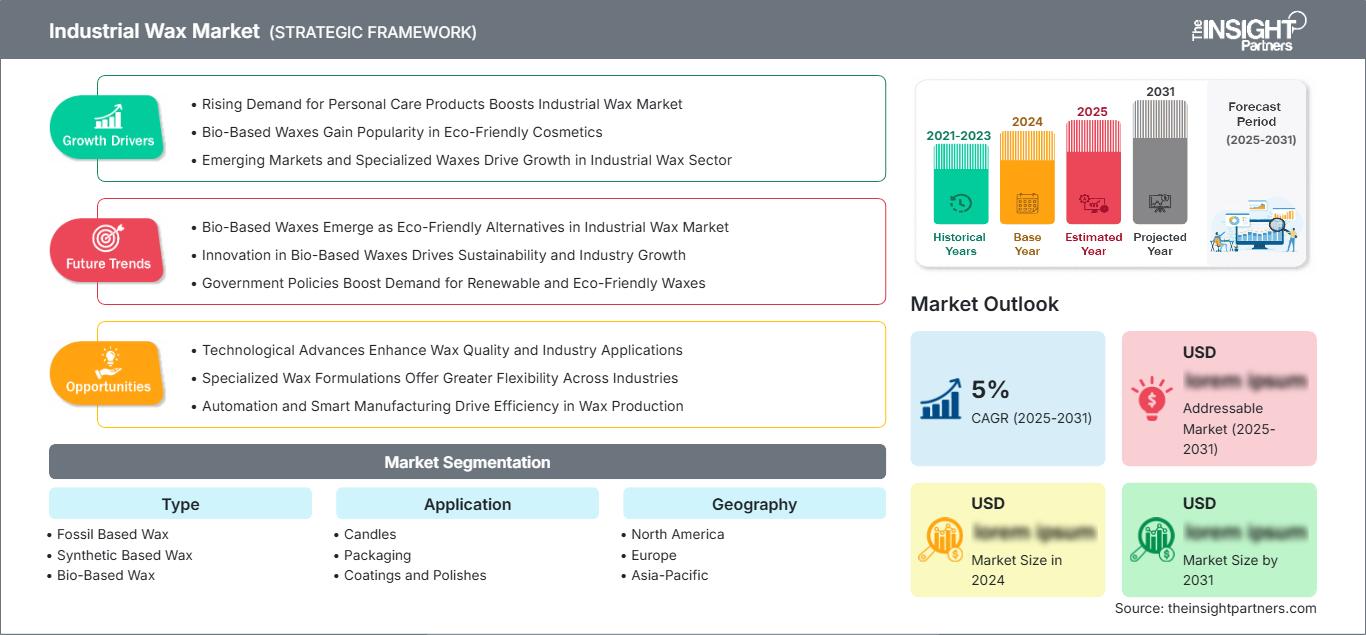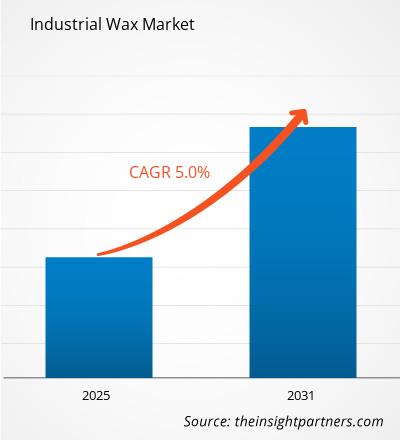Si prevede che il mercato delle cere industriali raggiungerà gli 11,23 miliardi di dollari entro il 2031. Si prevede che il mercato registrerà un CAGR del 4,9% nel periodo 2025-2031.
Il rapporto presenta un'analisi basata sulla tipologia (cera fossile, cera sintetica e cera di origine biologica). Il rapporto è segmentato per applicazione (candele, imballaggi, rivestimenti e lucidanti, adesivi hot melt, pneumatici e gomma, cosmetici e cura della persona, alimenti e altri). L'analisi globale è ulteriormente suddivisa a livello regionale e per i principali paesi. Le dimensioni e le previsioni del mercato a livello globale, regionale e nazionale per tutti i principali segmenti di mercato sono trattate nell'ambito di applicazione. Il rapporto fornisce il valore in dollari per l'analisi e i segmenti sopra indicati. Il rapporto fornisce statistiche chiave sullo stato del mercato dei principali attori e offre tendenze e opportunità di mercato.
Scopo del rapporto
Il rapporto "Industrial Wax Market" di The Insight Partners mira a descrivere il panorama attuale e la crescita futura, i principali fattori trainanti, le sfide e le opportunità. Ciò fornirà spunti a vari stakeholder aziendali, come:
- Fornitori/Produttori di tecnologia: per comprendere le dinamiche di mercato in evoluzione e conoscere le potenziali opportunità di crescita, consentendo loro di prendere decisioni strategiche informate.
- Investitori: per condurre un'analisi completa delle tendenze in merito al tasso di crescita del mercato, alle proiezioni finanziarie di mercato e alle opportunità esistenti lungo la catena del valore.
- Enti di regolamentazione: per regolamentare le politiche e le attività di controllo sul mercato con l'obiettivo di ridurre al minimo gli abusi, preservare la fiducia degli investitori e sostenere l'integrità e la stabilità del mercato.
Tipo di segmentazione del mercato della cera industriale
- Cera a base fossile
- Cera a base sintetica
- Cera a base biologica
Applicazione
- Candele
- Imballaggi
- Rivestimenti e lucidanti
- Adesivi hot melt
- Pneumatici e gomma
- Cosmetici e cura della persona
- Alimentari
Potrai personalizzare gratuitamente qualsiasi rapporto, comprese parti di questo rapporto, o analisi a livello di paese, pacchetto dati Excel, oltre a usufruire di grandi offerte e sconti per start-up e università
Mercato della cera industriale: Approfondimenti strategici

-
Ottieni le principali tendenze chiave del mercato di questo rapporto.Questo campione GRATUITO includerà l'analisi dei dati, che vanno dalle tendenze di mercato alle stime e alle previsioni.
Fattori di crescita del mercato delle cere industriali
- La crescente domanda di prodotti per la cura della persona stimola il mercato delle cere industriali: la crescita della domanda di cere industriali nel settore della cura della persona e dei cosmetici contribuisce a uno dei principali fattori trainanti. Le cere sono un componente importante nella maggior parte delle formulazioni cosmetiche, conferendo loro consistenza, stabilità e ritenzione dell'idratazione. La crescente domanda di prodotti per la cura della persona di qualità da parte dei consumatori, quindi, ne aumenta la quantità necessaria.
- Le cere a base biologica guadagnano popolarità nei cosmetici eco-compatibili: le cere a base biologica stanno guadagnando sempre più utilizzo con l'aumento della domanda di cosmetici naturali e biologici. I consumatori attenti all'ambiente optano per queste alternative e, di conseguenza, l'interesse degli investitori nella produzione di formulazioni di cere eco-compatibili è in aumento. Questa espansione sta anche contribuendo all'innovazione nel settore delle cere industriali.
- Mercati emergenti e cere specializzate guidano la crescita del settore delle cere industriali: la crescente domanda di prodotti di bellezza e cura della pelle nei mercati emergenti aumenta la domanda di cere industriali. L'aumento del reddito disponibile incoraggia i consumatori a spendere in cosmetici di alta gamma, stimolando così la crescita del mercato. Un ulteriore contributo a questo mercato in crescita è lo sviluppo di cere industriali specializzate per l'utilizzo in applicazioni specifiche come rossetti e creme.
Tendenze future del mercato delle cere industriali
- Le cere a base biologica emergono come alternative ecologiche nel mercato delle cere industriali: le cere a base biologica rappresentano l'ultima tendenza emergente con lo sviluppo delle cere industriali. Con la crescente attenzione dei consumatori verso una maggiore ecosostenibilità, aumenterà la domanda di alternative naturali sostitutive del petrolio. Le cere a base biologica si trovano naturalmente nelle piante e, pertanto, rappresentano un'alternativa più ecologica alle preferenze dei consumatori che stanno adottando sempre più la strada del rispetto dell'ambiente.
- L'innovazione nelle cere a base biologica stimola la sostenibilità e la crescita del settore: la transizione verso la sostenibilità influenza anche l'innovazione nella formulazione delle cere. Le cere a base biologica ad alte prestazioni per i settori cosmetico, del packaging, automobilistico e altri settori sono oggetto di continua ricerca e sviluppo. Tali innovazioni non solo rendono il prodotto più attraente per il mercato, ma possono anche facilitare la conformità a normative ambientali sempre più severe.
- Le politiche governative stimolano la domanda di cere rinnovabili ed ecocompatibili: l'aumento delle politiche governative in materia di cere a base di materiali rinnovabili sta dando impulso al mercato. Le politiche incentrate sulla riduzione dell'impronta di carbonio hanno sostenuto la preferenza per pratiche sostenibili nei settori che aumentano la domanda di prodotti biologici e aprono ai produttori opportunità per aggiornare la propria offerta e conquistare nuovi segmenti di mercato.
Opportunità di mercato per le cere industriali
- I progressi tecnologici migliorano la qualità delle cere e le applicazioni industriali: i progressi tecnologici stanno registrando un ruolo significativo nel mercato delle cere industriali come opportunità di crescita. Le tecniche di produzione migliorate includono una lavorazione e una raffinazione più raffinate con catalizzatori avanzati di qualità superiore, offrendo così cere dalle prestazioni superiori da utilizzare in una vasta gamma di settori.
- Le formulazioni di cere specializzate offrono maggiore flessibilità in tutti i settori: le formulazioni di cere specializzate per applicazioni speciali rappresentano un'altra tendenza di grande importanza. Ad esempio, i miglioramenti nella chimica delle cere hanno reso possibile la produzione di cere con proprietà specifiche come una maggiore stabilità termica e barriere all'umidità. Ciò ha aperto la strada a una maggiore flessibilità in più applicazioni oltre a cosmetica, packaging e automotive.
- Automazione e produzione intelligente promuovono l'efficienza nella produzione di cera: l'automazione e le tecnologie di produzione intelligente aumentano anche l'efficienza nella produzione di cera. Riducono i costi di produzione eliminando la generazione di sprechi inutili; inoltre, hanno semplificato i processi che migliorano i tempi di consegna. Tutto ciò crea l'opportunità per i produttori di rispondere meglio e più rapidamente alle mutevoli esigenze del mercato con innovazione e competitività.
Le tendenze regionali e i fattori che influenzano il mercato delle cere industriali durante il periodo di previsione sono stati ampiamente spiegati dagli analisti di The Insight Partners. Questa sezione illustra anche i segmenti e la geografia del mercato della gestione delle malattie del ritmo cardiaco in Nord America, Europa, Asia-Pacifico, Medio Oriente e Africa, America meridionale e centrale.
Ambito del rapporto sul mercato della cera industriale
| Attributo del rapporto | Dettagli |
|---|---|
| Dimensioni del mercato in 2024 | US$ XX Billion |
| Dimensioni del mercato per 2031 | US$ 11.23 Billion |
| CAGR globale (2025 - 2031) | 4.9% |
| Dati storici | 2021-2023 |
| Periodo di previsione | 2025-2031 |
| Segmenti coperti |
By Tipo
|
| Regioni e paesi coperti |
Nord America
|
| Leader di mercato e profili aziendali chiave |
|
Densità degli operatori del mercato della cera industriale: comprendere il suo impatto sulle dinamiche aziendali
Il mercato delle cere industriali è in rapida crescita, trainato dalla crescente domanda da parte degli utenti finali, dovuta a fattori quali l'evoluzione delle preferenze dei consumatori, i progressi tecnologici e una maggiore consapevolezza dei benefici del prodotto. Con l'aumento della domanda, le aziende stanno ampliando la propria offerta, innovando per soddisfare le esigenze dei consumatori e sfruttando le tendenze emergenti, alimentando ulteriormente la crescita del mercato.

- Ottieni il Mercato della cera industriale Panoramica dei principali attori chiave
Punti di forza
- Copertura completa: il rapporto analizza in modo esaustivo prodotti, servizi, tipologie e utenti finali del mercato delle cere industriali, offrendo una panoramica olistica.
- Analisi degli esperti: il rapporto è redatto sulla base della conoscenza approfondita di esperti e analisti del settore.
- Informazioni aggiornate: il rapporto garantisce la pertinenza aziendale grazie alla copertura di informazioni e dati recenti.
- Opzioni di personalizzazione: questo rapporto può essere personalizzato per soddisfare le esigenze specifiche del cliente e adattarsi in modo appropriato alle strategie aziendali.
Il rapporto di ricerca sul mercato delle cere industriali può quindi contribuire a guidare il percorso di decodificazione e comprensione dello scenario del settore e delle prospettive di crescita. Sebbene possano esserci alcune valide preoccupazioni, i vantaggi complessivi di questo rapporto tendono a superare gli svantaggi.
- Analisi storica (2 anni), anno base, previsione (7 anni) con CAGR
- Analisi PEST e SWOT
- Valore/volume delle dimensioni del mercato - Globale, Regionale, Nazionale
- Industria e panorama competitivo
- Set di dati Excel
Report recenti
Rapporti correlati
Testimonianze
Motivo dell'acquisto
- Processo decisionale informato
- Comprensione delle dinamiche di mercato
- Analisi competitiva
- Analisi dei clienti
- Previsioni di mercato
- Mitigazione del rischio
- Pianificazione strategica
- Giustificazione degli investimenti
- Identificazione dei mercati emergenti
- Miglioramento delle strategie di marketing
- Aumento dell'efficienza operativa
- Allineamento alle tendenze normative






















 Ottieni un campione gratuito per - Mercato della cera industriale
Ottieni un campione gratuito per - Mercato della cera industriale